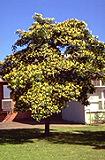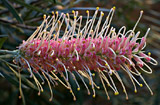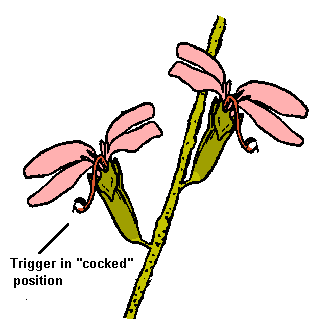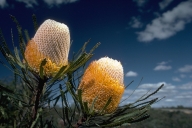|
[Front Page] [Features] [Departments] [Society Home] [Subscribe]

Electronic Mailbox
 
The following have been selected from the questions received on the ASGAP World Wide web site over the past few months. You're welcome to comment on any issue concerning Australian native plants....growing, propagating or appreciating (even loathing!) ... anything.
If necessary, bung a message in a bottle if your net connection goes down!!
....and, if you'd like to contact any of the correspondents and no email address is listed, please feel free to do so through the editor.

Native Frangipani
I was browsing the net and saw your site which is similar to a group I used to subscribe to many years ago...however in my literature I could not find anything about the native frangipani. I have a small tree growing in my yard and would like to try and propagate it but don't know how......some one told me it only grows from a seed and the seed must be from a old tree.
Can you help or point me in the right direction for info.
Nick Dragicevich
 |
Native frangipani, Hymenosporum flavum is popular in cultivation due to its moderate size and attractive, perfumed flowers.
Select the thumbnail image or highlighted name for a higher resolution image (52k).
|
There is some info on native frangipani on the web site.
The tree is usually propagated from seed. It doesn't need to be from an old tree but the seed needs to be fresh (ie sow it not long after the fruiting capsules open when the seed can be easily collected). Cuttings are also successful.
You can get some basic guidelines on propagation from the web site at:
I hope this helps.

Grevilleas from Seed
I have a number of grevilleas in the garden which are producing plenty of seed.
How can I propagate from this seed.
Kevin McGuire
Grevilleas are not the easiest plants to grow from seed - some species germinate well but others don't. There are some guidelines on the Society's web site - check out The Grevillea Page and the Plant Propagation section.
 
One other thing...Grevilleas are renowned for hybridising in the garden. This means that seeds often don't come true to the parent plant. For example, seeds from the hybrid "Misty Pink" (pink flowers) often produce plants with white flowers. The situation can be the same with other species and cultivars.
This is why most growers propagate garden-grown grevilleas from cuttings.
Select the thumbnail image or highlighted name for a higher resolution image (27k).

Black Bean in Europe
My name is M. Dolores Kerec-Kovac and I am a librarian working for the Forestry Library of the Slovenian Forestry Institute. I have a problem and surfing through the Internet I found your name and e-mail. As you can see by the subject of the mail I would like some information on Castanospermum australe. We have a pretty rich library and I have searched through all of our dendrological encyclopedia, manuals and other handbooks, trying to find something about this plant. It is, I believe a species of Australia, so it is rarely mentioned in European handbooks.
One of our researchers wants information on this plant, besides it has been imported to Europe and Slovenia as a decorative plant and people phone our library asking about it.
I would be very grateful to you if you could give me some information about this plant or at least where I can find it. I need a general description of the plant, propagation and cultivation.
Thank you very much in advance and greetings from our romantically white (from snow of course !!!!) city of Ljubljana.
Yours sincerely,
M. Dolores Kerec-Kovac
Great to hear from you - we don't get much contact from your part of the world!
Castanospermum australe is indeed an Australian plant and one that is quite widely cultivated.
It is found in rainforests along the east coast of Australia from Cape York in Queensland (the most northern point in Australia to the north coast of New South Wales). It is a member of the family Fabaceae and there is only a single species. It has a couple of common names (Black Bean; Morton Bay Chestnut).
A brief description.....
It is a medium to large tree up to 30 metres high x 12 metres wide but usually smaller in cultivation. The bark is smooth, grey to dark brown in colour. Leaves are pinnate up to 45 cm long with 8 to 17 oval leaflets about 12 cm x 5 cm. In spring it has large clusters of red or reddish yellow flowers which are followed by large seed pods containing up to 5 seeds which can be 4 to 5 cm diameter. The flowers contain a lot of nectar and attract birds.
The seeds are regarded as being poisonous and there are many records of people becoming ill after eating them. Cattle have died after eating large quantities.
The tree is widely cultivated and grows well in dry inland areas and cool climates quite different from its natural habitat. It grows well as a container plant and is often used for indoor decoration. It responds well to rich soils and is regarded as an easy-to-grow species here.
Propagation is easy from the seeds which don't need any special pre-treatment.
There is some more detailed information at the "Plants for a Future" web site.

Propagating Pomaderris
I'm hoping someone may be able to assist!
I would like any information on germinating some Pomaderris spp seeds which I was sent from Canberra, Black Mountain.
Do they require any special pre-treatment, seed raising mix etc? Any assistance would be much appreciated.
Kerrod Beattie
Queensland
Pomaderris is a very neglected genus in cultivation, but there are a number of species worth growing - if you can find plants!
John Wrigley has a few tips to pass on.....
Pomaderris are normally propagated from cuttings which strike fairly easily. However, some success has been had from seed by heating the seed in an oven for 10 minutes at 150oC. Other methods that have been used are to place the seed in freshly boiled waer for 15 minutes and scarifying the seed by rubbing between coarse emery paper prior to sowing.
The seed also needs to be freshly harvested.
 |
Pomaderris is an attractive genus but few species are commonly cultivated. This is Pomaderris humilis.
Select the thumbnail image or highlighted name for a higher resolution image (61k).
|

Euodia Woes....
I was wondering if someone could tell me what could possibly be wrong with a couple of Euodias I am trying to grow in Brisbane. One is the larger species and one is call the Little Euodia. Both are dropping leaves profusely which have first turned yellow. What could they be lacking? I water regularly because they are Rainforest trees and I fertilise about every 4-5 months. I have also tried trace elements,but nothing seems to be working.
Thank you for any hints.
Trish Nabarro
Brisbane
John Wrigley replies.....
Euodia (now Melicope elleryana) is found naturally in areas that are almost constantly wet and although you say that you water regularly, I wonder if you allow the roots to be soaked. The hot weather should not bother these plants if the roots are kept moist. It is best to water with a fixed spray rather than a hand-held hose to allow the water to penetrate deep into the soil.
The small euodia (Evodiella muelleri) also enjoys damp conditions. Both plants are hardy in cultivation and usually have no disease problems. I don't know what sort of fertiliser you use but both species would enjoy a dressing of Dynamic Lifter a couple of time a year in February and August in your climate.
Hope this helps.

Agapanthus....Environmental Weed??
I recently flippantly verbally assaulted a friend's decorative Agapanthus crop, declaring them an environmental weed and a danger to forests. (She is in the Seymour region, Victoria). She now wants proof!
Am I on the right track or was my attack hasty and unfounded? Can anyone point me towards some info?
"Agapanthus Assaulter"
Australia
Agapanthus is certainly an environmental weed in some areas (eg. Blue Mountains, NSW and parts of South Australia and Victoria and possibly elsewhere). I can't say for sure whether it's a problem in the Seymour area.
There is reference to Agapanthus as a weed on the following pages, but no detailed information, unfortunately:
Hope this helps your argument!

Plants to Grow Under Gum Trees
I have two large gums in our front garden and wonder what would be a good range of samll plants to grow under these trees.
David Gibbs
davidgibbs@netspace.net.au
Well, I can't give you a definitive list because it depends on where you are and what the soils are like. Generally, though, you can grow lots of plants in the root zone of eucalypts with one main proviso. Can you keep water supplied?
The biggest battle in trying to establish the plants is caused by the trees taking up moisture rapidly. Unless you can arrange to deliver water to the under-plantings on a regular basis, it will be difficult to get plants to thrive.
If the water problem can be addressed, plants worth growing are Prostanthera species ("mint bushes" - these wilt noticeably when stressed through lack of water and are useful as indicators of dryness), Eriostemon, Philotheca, Crowea, Correa. If the shade is not too dense, smaller banksias, tea trees and bottlebrushes would be worth trying.
If you can get hold of the book "Grow What Where" from a library, you'll find plant lists for all sorts of situations.

Lists of Fire Resistant Plants
Does ASGAP have a list of fire resistant native plants ? I've looked on your website and not found one ???
Many Thanks
Robyn Adams
adams@deakin.edu.au
Actually, there is a list on the web site but, perhaps it's not as easy to find as it could be. The list was compiled after the 1994 New South Wales' fires in response to many requests.
A caveat, however....the list has no scientific basis and was compiled from a number of sources both published and anecdotal. It can be found on our web site.
The Australian Flora Foundation funded a research project to look at the ingnitability of a range of Australian plants. I haven't seen the study but a brief report was published in the September 1999 issue of Australian Plants online.

Project on Australian Plants
I am doing a project for my English class after reading the book 'Walkabout'. The book takes place in the Australian desert and names a few different plants here and there. I do not know much about plants and I was hoping that you could give me some information about these different types of plants
mentioned in the book:
- Eucalyptus
- Banksia
- Acacia
- Sandalwood
- Ironbark
|
- Wattle
- Mulga
- Dodder
- Kurrajong
- Casuarina
|
Thanks a lot for your help!
Brian Marcks
Connecticut, USA
You'll find most of the info (+ photos) you need on our web site at the following links:
I Hope this helps .

What's a Stylidium?
I am looking for information about the stylidium orchid. Can you help? Please send any articles, or resources that may be helpful.
Renee Cothran
renee@summit.org
 
Stylidium isn't an orchid. It's a genus of 120 or so species with a grass-like habit or having a rosette of leaves at ground level. The flowers occur on stems arising from the middle of the leaves. They are called "trigger plants' because the flowers have a "column" which has a spring-like mechanism to deposit pollen on a visiting insect....see the diagram.
With a bit of luck, there will be an article on Stylidium in the June 2000 issue of Australian Plants online. In the meantime, you'll find information at the following links:

Seed Treatment
Just wanted to know is there any special treatment to the seeds of:
- Gymea lily (flame lily, spear lily etc)
- Pandanus (don't know what type it is)
- Lomandra longifolia
- Kauri and Hoop pine
before propagating and how does one grow NSW christmas bush? I have read, just place the flower (sepal and all) in some soil. Is this right?
Alan Hamilton
barracuda@fast.net.au
I'm not aware of any specific treatment for any of those listed except for Lomandra which may benefit from the use of smoke water.
You're right, the seed of Christmas bush is embedded within the old flower so just sow the whole thing. You might find, however, that germination is slow and far from 100%.

Mystery Plant
 
I was just having a look for a name of a flower for some pages I am doing for school students and I need to be correct in my identification. I had a look at the Australian Plant page and it is great, very comprehensive. I was wondering if you could identify the attached flower for me.
I thought it was a bottle brush but on looking at your page thought it may be a Banksia? Could you please help?
Glen
glen@powerup.com.au>
Well - it's certainly a Banksia.
Difficult to say which one but may be B.prionites or B.hookeriana, both native to Western Australia.

[Front Page] [Features] [Departments] [Society Home] [Subscribe]
Australian Plants online - March 2000
Association of Societies for Growing Australian Plants
|